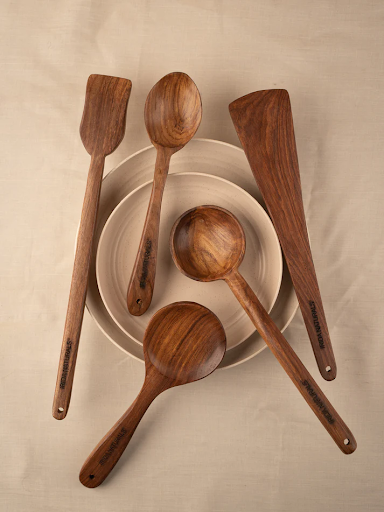Table Of Contents
- Summary
- Introduction
- The Wooden Ladle in Indian Cooking: More Than Just Stirring Curries
- Beyond the Pot: Ingenious Non-Culinary Uses for Your Wooden Ladle
- The Art of Maintenance: Step-by-Step Care for Your Wooden Ladle
- Wooden Ladle Wonders: Proven Durable Uses Through Time
- Conclusion
- FAQ's

Key Takeaways
- The wooden ladle is an essential tool for various culinary tasks in traditional Indian cooking.
- Besides cooking, the wooden ladle has ingenious non-culinary uses such as pest control and shaping dough.
- Proper maintenance, including hand washing and oiling, is crucial to preserve the quality & longevity of the wooden ladle.
- Wooden ladles are durable, environmentally friendly, and sustainable, making them a worthwhile investment for any kitchen.
Introduction
How often do you reach for your wooden ladle while cooking? Its role in Indian cuisine goes beyond stirring curries.Wood's absorbent qualities enable it to soak up flavors, thus enriching the taste of the dishes it is utilized in. But did you know that this humble utensil has ingenious non-culinary uses too? From pest control to a makeshift rolling pin, the wooden ladle is a versatile tool in any household. Proper maintenance is key to preserving its quality and beauty, ensuring its longevity. With its proven durability and eco-friendly appeal, the wooden ladle is more than just a cooking utensil. Join us as we explore the surprising uses of the wooden ladle and discover how it has stood the test of time, offering both functionality and sustainability.
The Wooden Ladle in Indian Cooking: More Than Just Stirring Curries
When it comes to traditional Indian cooking, the wooden ladle holds a significant place in every household. Its versatility goes beyond just stirring curries; it is an essential tool for various culinary tasks. From mixing spices to serving rice, the wooden ladle plays a crucial role in Indian kitchens. Wood's porous characteristics enable it to imbibe flavors, lending an additional layer of depth to the dishes it is used with. Furthermore, the ladle's smooth surface ensures it won't scratch cookware, rendering it perfect for use with sensitive cooking surfaces. The wooden ladle is an indispensable tool for Indian cooking, and its uses extend far beyond what meets the eye.
Beyond the Pot: Ingenious Non-Culinary Uses for Your Wooden Ladle
When it comes to wooden ladles, their functionality extends far beyond the realms of the kitchen. In fact, these versatile tools can serve a multitude of unexpected purposes throughout your home. Here are five surprising non-culinary uses for your wooden ladle:
- Pest Control: Believe it or not, a wooden ladle can be employed as a gentle and eco-friendly pest control tool. Its long handle and sturdy construction make it perfect for safely removing unwanted critters from your living spaces.
- Rolling Pin Substitute: In the absence of a traditional rolling pin, a wooden ladle can effortlessly step in to help flatten and shape dough with its smooth and rounded edges, making it a convenient alternative in a pinch.
- Meat Tenderizer: The smooth and rounded edges of a wooden ladle lend themselves perfectly to tenderizing meat without causing damage or tearing. It’s an effective and gentle way to prepare your meats for cooking.
- Massage Tool: The ergonomic design of a wooden ladle makes it ideal for use as a massage tool. Its smooth surface and rounded edges can be utilized to tenderize and marinate meats or even gently massage sore muscles and joints.
- Dough Shaper: The curved shape of a ladle can be used to shape and smooth dough when baking, proving to be an indispensable tool for bakers in need of precision and finesse.
These ingenious non-culinary uses highlight the adaptability and usefulness of the wooden ladle, making it an essential and multi-functional utensil to have in any Indian household.
Alt text: "A set of five wooden ladle on stacked ceramic plates against a beige cloth background."
The Art of Maintenance: Step-by-Step Care for Your Wooden Ladle
Proper maintenance of your wooden ladle is essential to ensure its longevity and performance. Unlike metal or plastic utensils, wooden ladles require specific care to prevent damage and maintain hygiene. The following guide will help you preserve the quality and beauty of your wooden ladle:
- After each use, hand wash the ladle with mild dish soap and warm water.
- Dry the ladle thoroughly with a clean towel to prevent moisture retention.
- To protect the ladle from drying and cracking, lightly coat it with food-grade mineral oil.
- Store the ladle in a well-ventilated area away from direct heat sources to prevent warping.
By following these easy steps, one can ensure that their wooden ladle remains in top condition for years to come.
Wooden Ladle Wonders: Proven Durable Uses Through Time
The enduring nature of the wooden ladle is a testament to its durability & timeless appeal. Unlike plastic or metal utensils, wooden ladles have been used for generations, standing the test of time. Their natural resistance to heat and their ability to prevent scratches on cookware make them an enduring choice in any kitchen.
What's surprising is that wooden ladles have proven to be versatile beyond their primary use in cooking. Here are five surprising uses for your wooden ladle:
- Herb Garden Helper: Use the rounded end of the ladle to create small indentations in the soil for planting seeds or seedlings in your herb garden.
- Fruit Flair: Turn your wooden ladle into a creative tool by using it to hollow out fruits for festive fruit salads or decorative fruit displays.
- Bath Time Buddy: A wooden ladle can double up as a gentle, natural scoop for pouring water during a relaxing bath, adding a touch of rustic charm.
- Crafty Creations: Get innovative by using the smooth surface of the ladle for painting or as a printing tool for creating unique designs on paper or fabric.
- Musical Magic: Explore the musical side of your wooden ladle by using it as a percussion instrument, creating rhythmic beats and sounds during impromptu jam sessions.
Moreover, wooden ladles are environmentally friendly & sustainable, making them an ideal choice for eco-conscious consumers. The proven durability of wooden ladles makes them a worthwhile investment for any kitchen, offering both functionality and longevity.
Conclusion
From stirring curries to serving rice, the versatile wooden ladle plays a crucial role in traditional Indian cooking. Its porous nature allows it to absorb flavors, while its smooth texture prevents scratching delicate cookware. Beyond the kitchen, the wooden ladle proves to be an ingenious multi-purpose tool, suitable for various household tasks. Proper maintenance, including hand washing, thorough drying, and application of food-grade mineral oil, ensures its longevity. The enduring nature of the wooden ladle, its proven durability, and eco-friendly appeal make it a worthwhile investment for any kitchen. Share your thoughts on the surprising uses of the wooden ladle in the comments below. Embrace the timeless tradition of using a wooden ladle in your kitchen!
FAQ's
Q1: What are some surprising uses for a wooden ladle?
Ans1: Besides stirring soups and stews, a wooden ladle can double as a salad server for gentle mixing without bruising the greens. It also serves as a handy herb muddler for cocktails and mocktails.
Q2: Can a wooden ladle be used for anything other than cooking?
Ans2: Absolutely! Use it as a plant stake for small potted plants or as a gentle back scratcher for those hard-to-reach spots.
Q3: How can a wooden ladle contribute to sustainable living?
Ans3: By using a wooden ladle, you’re reducing the need for plastic utensils, thus contributing to a sustainable lifestyle. It’s a small, eco-friendly choice that adds up in the long run.


